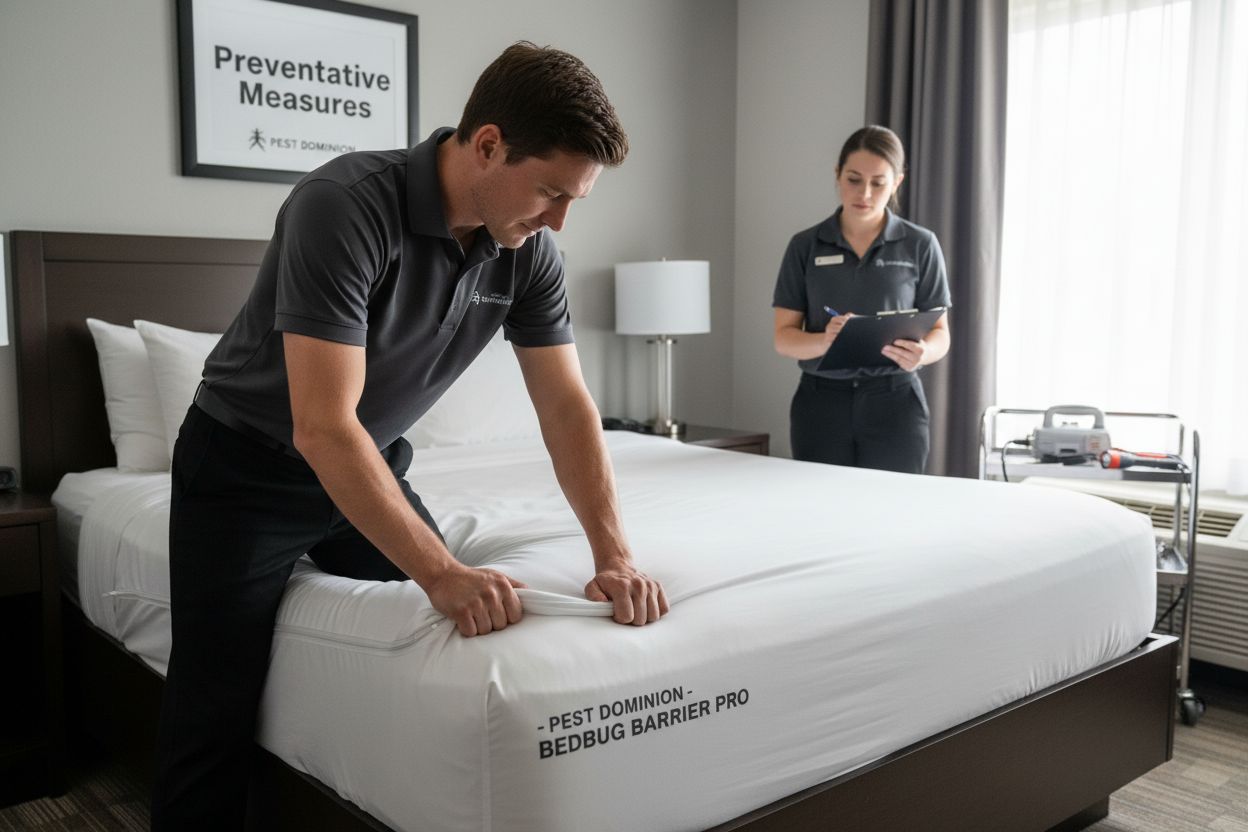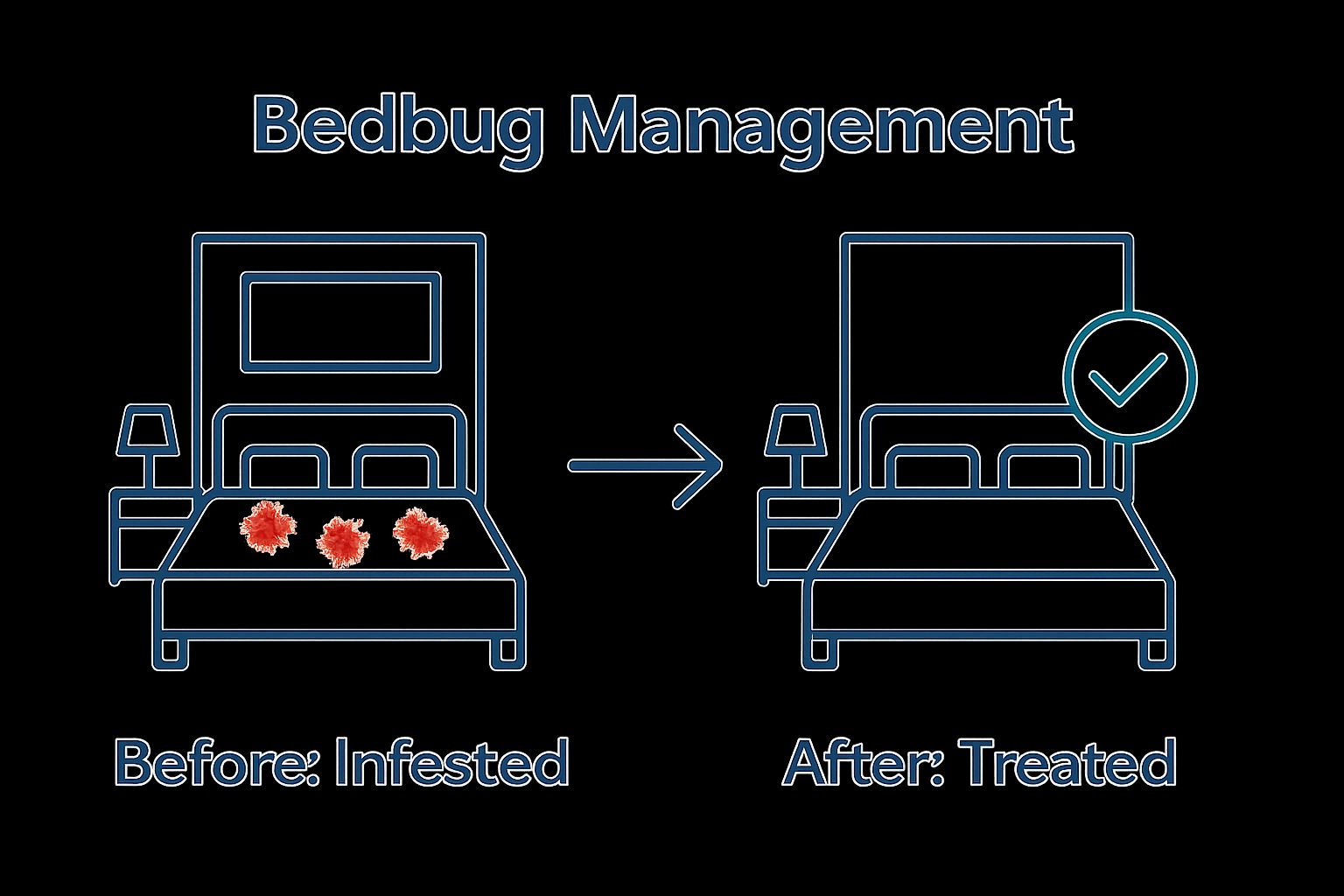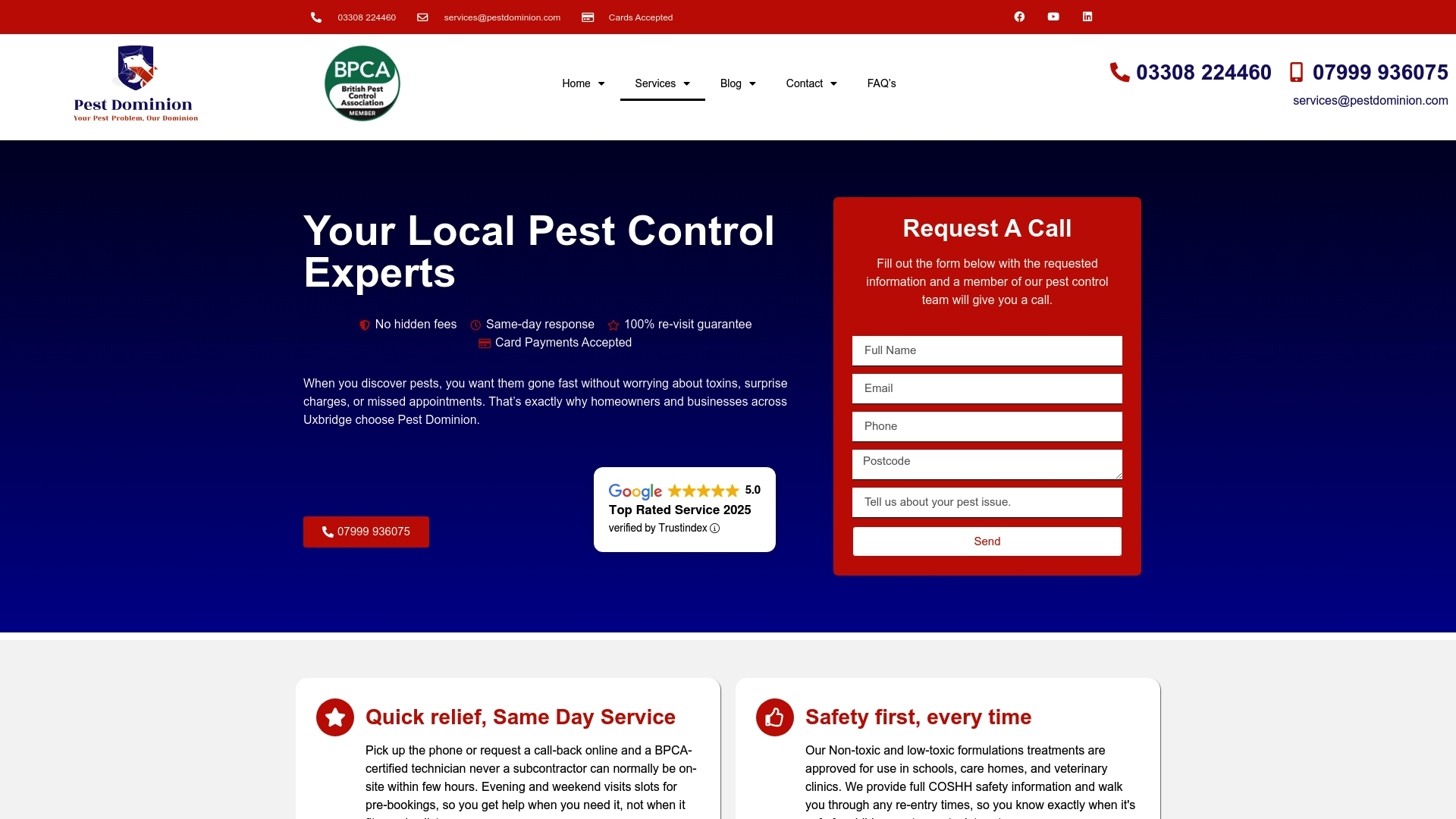Bedbugs are one of the most dreaded nightmares for hotel owners and guests alike. You might think these tiny pests are a rare nuisance, but an estimated one in five hotels in the UK reports a bedbug incident every year. More surprising still, routine cleaning alone is never enough to protect a hotel from infestation. The key difference is the detailed protocols and secret inspection zones that top hotels use to keep these stubborn intruders at bay.
Table of Contents
- Step 1: Inspect Guest Rooms Thoroughly
- Step 2: Implement Preventative Measures
- Step 3: Treat Infested Areas Effectively
- Step 4: Monitor and Evaluate Treatment Success
- Step 5: Educate Staff on Bedbug Management
Quick Summary
| Key Point | Explanation |
|---|---|
| 1. Thoroughly inspect guest rooms | Conduct detailed inspections of mattresses and furniture for bedbug signs to prevent infestations. |
| 2. Use protective encasements and treatments | Invest in encasements and insecticide treatments to deter bedbug entry and migration. |
| 3. Train staff on bedbug management | Provide comprehensive training for all staff on identifying and handling potential infestations promptly. |
| 4. Implement rigorous monitoring systems | Establish systematic follow-up inspections and use traps to detect any remaining bedbugs early. |
| 5. Document and evaluate all findings | Keep meticulous records of inspections and treatments to track effectiveness and patterns. |
Step 1: Inspect Guest Rooms Thoroughly
Inspecting guest rooms thoroughly is the critical first line of defence against bedbug infestations. This comprehensive examination requires meticulous attention to detail and a systematic approach to identifying potential signs of these elusive pests before they can spread and cause significant problems for your hotel.
Identifying Bedbug Hotspots
Bedbug inspections demand precision and strategic focus. Start with the bed area, which represents the primary zone of potential infestation. Carefully examine mattress seams, headboard crevices, and box spring edges where bedbugs frequently hide. Use a bright flashlight to illuminate dark corners and tight spaces, looking for telltale signs such as dark faecal spots, shed skin, or tiny rust-coloured stains indicative of bedbug activity.
Move beyond the bed to inspect additional furniture. Carefully check upholstered chairs, curtain folds, wooden furniture joints, and electrical outlet covers. Pay special attention to nightstand drawers, behind picture frames, and inside wardrobe corners. Professional pest controllers recommend using a magnifying glass to detect minute bedbug evidence that might escape casual observation.
Documentation and Systematic Checking
Create a standardised inspection checklist to ensure consistency across all guest rooms. Document each room’s condition meticulously, recording any suspicious findings immediately. Wear disposable gloves during inspections to prevent potential cross-contamination between rooms. Consider using white paper towels underneath areas being examined to make bedbug detection easier.
Key verification criteria for a successful room inspection include:
- No visible live or dead bedbugs
- No dark faecal spotting on mattresses or furniture
- No blood stains on bedding or surrounding areas
- No shed bedbug skins or egg casings
If any signs of bedbugs are discovered, immediately isolate the room and contact professional pest control services. Swift, decisive action prevents potential widespread infestation and protects your hotel’s reputation.
Below is a checklist summarising the verification criteria for a successful bedbug inspection in hotel guest rooms.
| Inspection Criteria | Description |
|---|---|
| No live or dead bedbugs | Guest room is free of both living and dead bedbugs upon inspection. |
| No faecal spotting | There are no dark faecal marks on mattresses, bed frames, or furniture. |
| No blood stains | Bedding and surrounding areas do not exhibit any rust-coloured blood stains. |
| No shed skins/egg casings | No bedbug skins or egg casings present in seams or hidden crevices. |
| Immediate isolation protocol | Any room with suspicious signs is isolated and pest control is contacted instantly. |
| Standardised record-keeping | Inspection and findings for each room are thoroughly documented. |
Step 2: Implement Preventative Measures
Implementing robust preventative measures is crucial in creating a comprehensive defence against bedbug invasions in hotel environments. This strategic approach goes beyond simple inspection and creates multiple layers of protection to minimise the risk of potential infestations.
Protective Equipment and Encasements
Begin by investing in high-quality mattress and box spring encasements specifically designed to prevent bedbug entry and entrapment. These specialised protective covers create an impenetrable barrier that prevents bedbugs from establishing themselves within mattress structures. Opt for light-coloured encasements that make potential bedbug detection easier during routine inspections. Ensure these encasements are completely sealed with robust zippered closures and made from tear-resistant materials.
Extend protective strategies to furniture beyond beds. Consider treating wooden bed frames, headboards, and surrounding furniture with residual insecticide treatments that provide long-lasting protection. These treatments create an additional deterrent layer that interrupts potential bedbug migration pathways. Professional pest control technicians can apply these treatments with precision, ensuring comprehensive coverage without compromising guest safety.
Training and Monitoring Systems
Develop a comprehensive staff training programme focused on bedbug prevention and early detection. Educate housekeeping personnel about recognising potential bedbug signs, understanding reporting protocols, and implementing immediate isolation procedures when suspicious activity is discovered. Create clear, step-by-step guidelines that empower staff to respond quickly and systematically.
Implement advanced monitoring technologies to enhance preventative capabilities. Bedbug interceptor traps placed strategically beneath bed legs can capture and indicate potential pest movement. These passive monitoring devices provide an additional layer of surveillance, allowing staff to detect potential issues before they escalate.
Key preventative verification criteria include:
- All mattresses and box springs completely encased
- Staff thoroughly trained in bedbug identification
- Monitoring traps installed in high-risk rooms
- Regular inspection schedules maintained
- Immediate isolation protocols established
By creating these multiple defensive layers, hotels significantly reduce bedbug invasion risks. According to Environmental Protection Agency, proactive prevention represents the most cost-effective strategy in managing potential pest challenges.
 Consistent implementation and staff vigilance transform these measures from reactive solutions to robust, systematic pest management protocols.
Consistent implementation and staff vigilance transform these measures from reactive solutions to robust, systematic pest management protocols.
Step 3: Treat Infested Areas Effectively
Treating bedbug-infested areas demands a strategic and comprehensive approach that combines professional expertise, targeted chemical treatments, and meticulous cleaning protocols. The goal is not merely to eliminate visible pests but to create a comprehensive eradication strategy that prevents future reinfestation.
Chemical and Non Chemical Treatment Strategies
Professional heat treatment represents one of the most effective methods for eliminating bedbugs comprehensively. Specialised equipment raises room temperatures to 55-60 degrees Celsius, ensuring complete pest destruction across all life stages. This technique penetrates deep into mattresses, furniture, and wall cavities, reaching areas that traditional chemical treatments might miss. When combined with precise temperature monitoring, heat treatment provides a non-toxic solution that leaves no chemical residue and minimises potential risks to guest health.
Chemical treatments should be applied strategically by trained pest control professionals. Residual insecticide sprays targeting specific bedbug habitats can provide extended protection.
This table compares the main treatment strategies for bedbug infestations, outlining their methods, advantages, and considerations.
| Treatment Method | Main Features | Advantages | Considerations |
|---|---|---|---|
| Professional heat treatment | Raises room temperature to 55-60°C | Kills all life stages, non-toxic, no residues | Requires specialist equipment and trained professionals |
| Residual chemical insecticides | Targeted spraying of key hiding spots | Extended protection, professional-grade options | Guest safety and precise application essential |
| Steam cleaning | High-temperature steam applied to infestations | Kills bedbugs and eggs, chemical-free | Effectiveness depends on thoroughness, useful for textiles |
| Washing textiles above 60°C | Laundering bedding, curtains, and soft furnishings | Ensures total elimination of bedbugs and eggs | Not suitable for non-washable items, repeat as needed |
Complement chemical treatments with thorough cleaning protocols. Steam cleaning provides an additional layer of decontamination, effectively killing bedbugs and their eggs through high-temperature exposure. Wash all potentially contaminated textiles like bedding, curtains, and soft furnishings at temperatures exceeding 60 degrees Celsius to ensure complete pest elimination.
Verification criteria for successful treatment include:

- No live bedbugs detected during follow-up inspections
- No new bedbug eggs or larvae present
- Zero signs of active infestation after 30 days
- Comprehensive treatment documentation completed
Remember that successful bedbug management requires patience and persistence. Learn more about our comprehensive pest control strategies to develop a robust, long-term solution. According to Environmental Protection Agency, professional integrated pest management approaches offer the most reliable outcomes in bedbug eradication.
Step 4: Monitor and Evaluate Treatment Success
Monitoring and evaluating treatment success represents the critical final phase in comprehensive bedbug management. This systematic approach ensures that initial treatment efforts have been effective and prevents potential future reinfestations by identifying and addressing any remaining pest populations.
Implement a rigorous post-treatment monitoring protocol that involves methodical inspections across all treated areas. Conduct detailed examinations every two weeks for a minimum of two months following initial treatment. Use specialised bedbug monitoring tools such as adhesive interceptor traps placed strategically beneath bed legs and furniture bases. These passive monitoring devices capture any remaining or newly introduced bedbugs, providing early warning of potential recurring issues.
Develop a comprehensive documentation system to track inspection findings meticulously. Create standardised inspection forms that allow staff to record precise details about potential bedbug activity. Photograph evidence of any suspicious findings, creating a visual record that can help track potential pest movement and treatment effectiveness. Digital documentation enables precise tracking and allows for quick identification of emerging patterns or problem areas.
Training housekeeping and maintenance staff becomes paramount during this monitoring phase. Educate personnel about subtle signs of bedbug presence, including tiny rust-coloured stains, shed skin, and minute faecal spots. Establish clear reporting mechanisms that encourage staff to communicate potential observations immediately. Empower employees to become active participants in ongoing pest management strategies.
Key verification criteria for successful monitoring include:
- Zero live bedbugs detected during follow-up inspections
- No new bedbug eggs or larvae present
- Clean and consistent interceptor trap results
- Comprehensive treatment documentation completed
- Staff trained and vigilant in ongoing detection
Remember that successful bedbug management requires persistent vigilance and proactive strategies. According to HealthLink BC, continuous monitoring remains the most effective method of ensuring long-term pest control. By maintaining a systematic, documented approach, hotels can protect their reputation and provide guests with a safe, comfortable environment free from pest-related concerns.
Step 5: Educate Staff on Bedbug Management
Educating staff represents a fundamental pillar in effective bedbug management, transforming employees from potential vulnerabilities into proactive defenders against pest infestations. A well-trained workforce becomes the hotel’s first line of defence, capable of identifying, reporting, and preventing potential bedbug challenges before they escalate.
Design a comprehensive staff training programme that combines theoretical knowledge with practical, hands-on learning experiences. Develop interactive workshops that provide detailed visual guidance on bedbug identification, focusing on recognising subtle signs such as rust-coloured stains, shed skin, and minute faecal spots. Utilise high-resolution photographs and actual preserved specimen samples to help staff understand the nuanced characteristics of different bedbug life stages. Learn more about understanding bed bugs in depth to enhance your team’s knowledge base.
Implement a structured training curriculum that covers multiple critical aspects of bedbug management. Housekeeping staff require specialised training in systematic room inspection techniques, understanding how to examine mattress seams, furniture joints, and hidden crevices effectively. Teach precise cleaning protocols that minimise potential pest spread, including proper handling of potentially contaminated linens and thorough vacuuming techniques. Emphasise the importance of immediate reporting and isolation procedures when suspicious signs are discovered.
Establish clear communication channels and reporting mechanisms that empower staff to act decisively. Create simplified reporting forms that allow quick, standardised documentation of potential bedbug sightings. Develop a culture of accountability where every team member understands their role in maintaining the hotel’s pest management standards. Conduct regular refresher training sessions to ensure knowledge remains current and staff remain vigilant.
Key verification criteria for successful staff education include:
- All staff complete comprehensive bedbug management training
- 90% accuracy in bedbug identification during assessment tests
- Clear understanding of reporting and isolation protocols
- Documented evidence of training completion
- Demonstrated confidence in handling potential infestations
According to Centers for Disease Control and Prevention, ongoing staff education represents the most effective preventative strategy in managing potential bedbug challenges. By investing in thorough, engaging training programmes, hotels can transform their workforce into skilled pest management professionals.
Ready to Safeguard Your Hotel From Bedbugs?
Hotels face a major challenge when bedbugs threaten guest comfort and reputation. As explored in our complete guide, early detection, thorough inspection and fast intervention are essential. Yet even with strong in-house efforts, the frustration and anxiety of persistent infestations can disrupt business, damage brand trust and overwhelm staff. If you need more than a do-it-yourself solution, professional support is within easy reach.

Trust Pest Dominion Limited to provide the decisive advantage your hotel requires. Our accredited specialists deliver rapid response, discreet treatment and total peace of mind across Slough and neighbouring towns. Whether you want a professional inspection or urgent bedbug eradication, you can contact us today for fast help and friendly advice. Do not let a bedbug incident spin out of control—protect your guests and maintain your reputation with proven, local expertise now.
Frequently Asked Questions
What are the signs of a bedbug infestation in hotel rooms?
Look for small rust-coloured stains on bedding, dark faecal spots, shed skins, and live bedbugs along mattress seams, headboards, and other furniture.
How can hotels prevent bedbug infestations?
Hotels can prevent infestations by using mattress and box spring encasements, training staff on identification and reporting procedures, and implementing monitoring systems like interceptor traps.
What treatment options are available for bedbug infestations?
Effective treatment options include professional heat treatments, targeted chemical insecticide applications, and thorough cleaning protocols such as steam cleaning and washing affected textiles.
How often should hotels conduct inspections for bedbugs?
Hotels should conduct inspections systematically, with recommendations suggesting every two weeks for a minimum of two months following initial treatment, along with regular scheduled inspections to maintain vigilance.
Recommended
- Cockroach Guide: Life Cycle, Treatment Methods, and Prevention Tips – Pest Dominion, Your Local Pest Control Services
- Understanding Bed Bugs – Pest Dominion, Your Local Pest Control Services
- How Can You Stay Safe From Bed Bug Infestation In Southall? – Pest Dominion, Your Local Pest Control Services
- Understanding Bed Bugs – Pest Dominion, Your Local Pest Control Services

